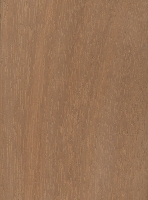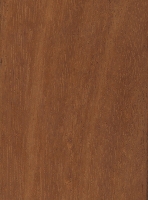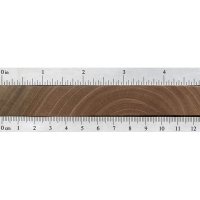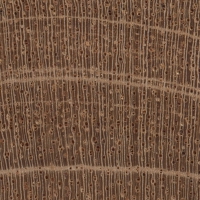 |
Common Name(s): Cuban Mahogany, West Indies Mahogany Scientific Name: Swietenia mahogani Distribution: Southern Florida and the Caribbean Tree Size: 65-100 ft (20-30 m) tall, 3-5 ft (1.0-1.5 m) trunk diameter Average Dried Weight: 37 lbs/ft3 (600 kg/m3) Specific Gravity (Basic, 12% MC): .53, .60 Janka Hardness: 930 lbf (4,120 N) Modulus of Rupture: 10,790 lbf/in2 (74.4 MPa) Elastic Modulus: 1,351,000 lbf/in2 (9.31 GPa) Crushing Strength: 6,280 lbf/in2 (43.3 MPa) Shrinkage: Radial: 3.0%, Tangential: 4.6%, Volumetric: 8.0%, T/R Ratio: 1.5 |
Color/Appearance: Heartwood color can vary a fair amount with Cuban Mahogany, from a pale pinkish brown, to a darker reddish brown. Typically, the denser the wood, the darker the color. Color tends to darken with age. Mahogany also exhibits an optical phenomenon known as chatoyancy. (See video below.)
Grain/Texture: Grain can be straight, interlocked, irregular or wavy. Texture is medium and uniform, with moderate natural luster.
Rot Resistance: Varies from moderately durable to very durable depending on density and growing conditions of the tree. (Older growth trees tend to produce darker, heavier, and more durable lumber than plantation-grown stock.) Resistant to termites, but vulnerable to other insects.
Workability: Typically very easy to work with tools: machines well. (With exception to sections with figured grain, which can tearout or chip during machining.) Slight dulling of cutters can occur. Sands very easily. Turns, glues, stains, and finishes well.
Odor: No characteristic odor.
Allergies/Toxicity: Although severe reactions are quite uncommon, Cuban Mahogany has been reported as a skin irritant. See the articles Wood Allergies and Toxicity and Wood Dust Safety for more information.
Pricing/Availability: For the most part, Cuban Mahogany is no longer commercially available. Very small quantities are occasionally made available, which tend to be expensive.
Sustainability: This wood species is in CITES Appendix II, and is on the IUCN Red List. It is listed as endangered due to a population reduction of over 50% in the past three generations, caused by a decline in its natural range, and exploitation.
Common Uses: Furniture, cabinetry, turned objects, veneers, musical instruments, boatbuilding, and carving.
Comments: Historically, perhaps the most celebrated and revered cabinet and furniture wood in the world. Cuban Mahogany has been used extensively in cabinetry and furniture-making for centuries in Europe and the United States, being harvested to the point of complete depletion. Nearly 100 years ago, H.O. Neville wrote of the wood’s exploitation in his 1919 work, Hardwoods of Cuba:
For domestic purposes, the Mahogany is used in such freedom that it seems sacrilege to the newcomer from the North, who has known this wood only in its finished and very expensive forms. Many hundreds of cords of this timber, ranging from 12 inches in diameter down, are annually burned under the boilers of our sugar mills and locomotives: hundreds of trees of the proper sizes are annually cut down and rough-hewed into railroad ties; and for posts, corralled fences, and the myriad other uses of the plantation, Mahogany is utilized. There will come a day not very far distant when the waste of this valuable timber will be regretted.
In 1946, Cuba banned all exporting of the wood due to over-harvesting and high demand; it has also been in scarce supply from other sources in the Caribbean as well. Today, the lumber has become so obscure that the term “Genuine Mahogany” now applies almost exclusively to its close substitute, Honduran Mahogany (Swietenia macrophylla), rather than the Cuban wood that for centuries has simply been referred to as “Mahogany.”
Cuban Mahogany’s easy workability, combined with its beauty and phenomenal stability have made this lumber an enduring favorite.
[iframe id=”https://www.youtube.com/embed/f7ggJD7Tjgs?rel=0″]








Hello. Any idea on these wood types?
Thank you.
Hi All, I salvaged two large slabs from large house on a private estate just before it was demolished about 5 years ago. I was told the house was built circa 1950 by a retired admiral and the both slabs were used as long bench seats. The first slab I’m sure is Honduran Mahogany, but the second one I’m hoping someone might be able to help identify. It’s 14ft long, 21.5″ wide and 2″ thick rift sawn. Almost entirely clear, with only one small bark inclusion. Grain is mildly interlocked. I calculated the weight from a sample at approx. 39… Read more »
I recently acquired about 10 board feet of Cuban Mahogany when they pulled up the flooring from a Victorian Era mansion. I absolutly love this stuff, gorgeous with a beautiful glow. Huge variation between the boards, especially since they are now newly planed and the old finish is gone. I feel so lucky to have scored these boards, especially since they are much wider than 2.5 inch thickness used today.
Having read what Neville wrote, I couldn’t believe such a beautiful wood would be used as firewood, railroad ties, and other uses. Recently I was sorting through some wood to sell that I purchased 25 years ago from the estate of a furniture maker and it turns out that it is Cuban Mahogany.
You can see from the attached pictures as Mr Neville wrote, that it was used at one time as packing crates.
Years ago I machined some of this mahogany to make a flag holder for a deceased veteran, and the wood looked fantastic.
Actually stamped Cuba! Amazing boards.
Can you please tell me what is this one?
Plantation grown, as the growth rings are very wide/spread apart and the edge grain is not very detailed, as seen in the original genus of Mahogany. Back then even 12″ logs (I’ve heard up to 24″) were just used as firewood.
I really appreciate your site it’s super easy to work through and your information has helped tremendously. It’s no wonder there’s amazing instrument made from these woods
Is this cuban ?
There’s really no way of knowing from those pictures alone.
I am No expert, but from what research I have done, it May be. Nice.
I have a dining room set that was made for a railroad engineer (a family connection) working in the oriente province of Cuba in about 1910. He selected trees during the clearing process, had them cut, and had his furniture made. The wood is beautiful, but what I find most incredible about it is the weight; the table leaf (14 5/8″ x 45″) weighs 20 lbs.
Hi, I recently got some lumber that was apparently stored for a long time prior. I have no idea what it actually is. Here is a photo of its slighty sanded endgrain.
Hi everyone, I am fairly new to working with wood, but I have a couple of good sources that I can get this for free. One of them as given me this lot and I have looked online and think that this is the real deal for mahogany from what I have read, but cannot be totally sure, any chance one of you more knowledgeable folks can help me identify the exact type of wood that this is from the photos that I have attached. Thank you in advance and this would be very much appreciated.
I do see storied rays and ripple marks on the face grain, which is a good sign. But we’d really need to see a clear, sanded, closeup shot of the endgrain to get a better idea.
Hi Eric, thank you for taking the time to look, I have the two pictures of the endgrain available, hope that these are clear enough otherwise I will plain some up at the weekend and post. Thanks in advance Steve
I can’t make out clear enough detail from those pics. They look weird, almost like a painting or something. You would need to sand the endgrain more thoroughly, to a finer grit, and then photograph it in a well lit space, such as direct sunlight.
Yep thats def tropical mahogany. hard to tell what kind without looking up close. most def some really nice pieces. The ones with black specks are nicer and more favored for guitar making.
Yup it sure is. I’ve been working with original Mahogany from antique sources and this is exactly it, and the look of freshly planed boards–there’s variation between color, but no mistaking that characteristic look.
If you can get it for free take as much as you can; honestly that goes for any antique hardwoods in my opinion.
I got an early 1900s dresser that I think is mahogany but as I have never worked with any I wouldn’t know what to compare with. Any chance someone can identify this piece for me please? Endgrain photo shows some white bands around the growth rings. One photo show a piece that I sanded the old shellac off and rubbed down with some water, the other photo is of the unfinished timber inside one of the drawers. Thanks
Yes, those white bands around the growth rings are what is called marginal parenchyma, and that is a key way to ID genuine Honduran mahogany from other types such as African mahogany. https://www.wood-database.com/wood-articles/mahogany-mixups-the-lowdown/
Thanks for your reply Eric. From reading your articles do I understand correctly that there isn’t an easy way to know whether it may be Cuban or Honduran mahogany? Is there any advantage knowing which one it may be?
regards, Lachlan
Yes, there’s not really any way of conclusively telling the two apart. Generally, items like guitars that have Cuban mahogany tend to be older and more valuable. But from a practical standpoint, I’m not fully convinced that there’s any appreciable difference in the wood of the two trees themselves. Mahogany is in itself a highly variable material and can vary quite a bit from tree to tree depending on growing conditions, so perhaps a lot of the debates surrounding the two species have been simply comparing a moving target that’s different depending on each person’s background experience with each of… Read more »
Well either way I can definitely say it looks amazing on my ukulele. Thanks again for your comments.
Eric’s reply was pretty much spot on; however, one thing I can add now that I am working a lot of Cuban Mahogany is the end grain are all very tight, much tighter than currently available. I also think the edge grain looks more intricate, but alas that could just be the “moving target”, and or the source of the antique Cuban boards I acquired (ie. maybe not everything out of Cuba was the same standard).
I’m hoping to identify the type of mahogany this is. The carvings and wood sample are possibly from the early 1900’s.
The sample has been sanded to 220 grit and is unfinished. The endgrain photo is best viewed enlarged and of the lower right hand corner.
There is no noticeable odor.
I appreciate any help you can provide.
Yes, judging by the pics, and also considering the age of the item, it does appear to be a genuine Swietenia species.
Do you think this might be “genuine mahogany “?
It was a windowsill from a 1920’s building in Chicago.
Yes, it’s certainly very probable. The endgrain matches well.
3rd pair from Italy/Switzerland
I need help identifying some paired samples:
1st pair is Flat/Riff Sawn (sealed but not filled) and End Grain – my guess is Red Meranti. It comes from an old futon frame
2nd pair is Riff Sawn and End Grain (slighted wetted) – possibly African Mahogany? Found in the attic of a house we bought in VA, USA
3rd pair is Riff Sawn and End Grain (both sanded) It was part of the interior frame of an Italian/Swiss couch.
No noticeable odor for any sample
I picked up an end table for $5 that was really beaten up. After stripping and standing (was stained to the darkness of walnut), I’m wondering if it’s Cuban mahogany, but I’m newish to wood identification. Is anyone able to confirm? See the unfinished, in progress, and finished (clear shellac only) photos. Thanks in advance
Genuine mahogany is a possibility. But it could also be African mahogany or an Asian species in the Shorea genus. Getting a closer image of an endgrain surface (such as the top of one of the legs) might help give more clues for identification. Also, you can take a look at my article on mahogany for more info. https://www.wood-database.com/wood-articles/mahogany-mixups-the-lowdown/
Eric, thanks for your response. Very interesting. Here are a few more shots – but not a lot of areas to see the endgrain. I was originally thinking Santos Mahogany due to the color but there was no odor when sanding.
The raw wood color is too pale for santos mahogany, it looks a lot closer to Honduran or African mahogany. Judging from the endgrain pics, I don’t see any marginal parenchyma, which would hint more toward a Khaya species (African mahogany).
Very interesting! Thanks for the information, makes me appreciate the table even more.
Recently my mother inherited some 100+ year old wood that used to be a piano case. I’m not sure what kind it is, though Cuban or Honduran mahogany seems a good possibility. Any opinions? See attached.
That actually looks like oak, not mahogany.
positive thats White Oak
I am a retired furniture restorer. One of my best customers brought in a round table 61.5 inches in diameter. She asked me to refinish the table. First thing I do is become a detective. I found out her grandmother bought this after the stock market crash. Round top circular base claw feet hand carved . This table wad made before 1880. This was one piece of lumber 5 feet in diameter 1 and 1/4 thick Cuban mahogany she had records of the vessel coming over to Florida with the furniture. I knew when I saw it but I had… Read more »
Did you by chance take any pictures of this piece? Sounds interesting.
No sorry I lost a few hundred photos buy a computer wiz who deleted 30 years of work
I have the pleasure to work with this wood.
For me the Cuban mahogany is the kind of mahogany’s.
The weight of 37 lbs/ft3 seems wrong to me.
Cuban is More dense than Honduran mahogany . I have both.
The tone of this wood is incredible. ???
Salvaged handrail and balusters from a 100-140 year old house look like Mahogany but the latewood(?) is very dark rather than the whitish in these photos. The rays and pores look just like this photo.
I’ve flipped through the entire book and don’t see anything that more closely resembles it than this, except for that color.
The wood is darker than the samples shown here.
Could the color change be a result of age?
Mahogany is highly variable in both weight and color, so I wouldn’t use that as a basis of ID. Have you seen this article? https://www.wood-database.com/wood-articles/mahogany-mixups-the-lowdown/
Thank you for the reply. Can you offer suggestions on distinguishing S. mahogani, S. macrophylla, and Carapa spp.? I see differences in the endgrain photos but can’t describe them.
I am not aware of any discernible differences between the Swietenia species. I’m guessing that any variability that you’re seeing can be chalked up to natural variability between different trees and growing conditions. As for andiroba (Carapa spp.), it is harder to tell them apart, but generally andiroba has slightly darker reddish brown parenchyma bands, while the bands in Swietenia are lighter in color and contrast against the surrounding wood fibers more.
In the representative photos of endgrain here, it appears that the Swietenia species have thicker parenchyma, perhaps even typically significantly thicker/wider than the rays. The Carapa endgrain photo shows parenchyma with very uniform width similar to the width of the rays. Does that hold in general or just the particular samples shown?
I’d guess the parenchyma bands in this photo are a bit wider than average.
Are there ever dark bands in Swietenia? This sample is from the old house so it may have been installed 140-160 years ago. This is from a painted stair post so I haven’t seen much edge grain. It also appears to have reticulated parenchyma- does old mahogany develop that characteristic?
I’m not sure I would call that full blown reticulate parencyhma, it might be more like diffuse-in-aggregates or just banded. And no, this is not something seen in Swietenia species, so this casts doubt on ID. For what it’s worth, diffuse porous hardwoods like this are about the hardest of all wood types to ID.
That helps a lot, thanks.
Are the dark bands also a disqualifier for Swietenia species?
I’ve seen a lot of natural color variation in the wood fibers, so I don’t think that alone would be a disqualifier.
I am a wood sculptor and have used a few different species of Mahogany over the years, for me the smell of Cuban Mahogany is very distinctive, I can only describe the smell as ‘old pianos’, other types don’t seem to have the same odour, or at least not the ones I have used. I hope this helps.
I agree! I was calling it old faint cigar boxes. No where near the strong smell of a cigar box, it’s just what my mind associated. Nevertheless, the smell is distinctive to me too.